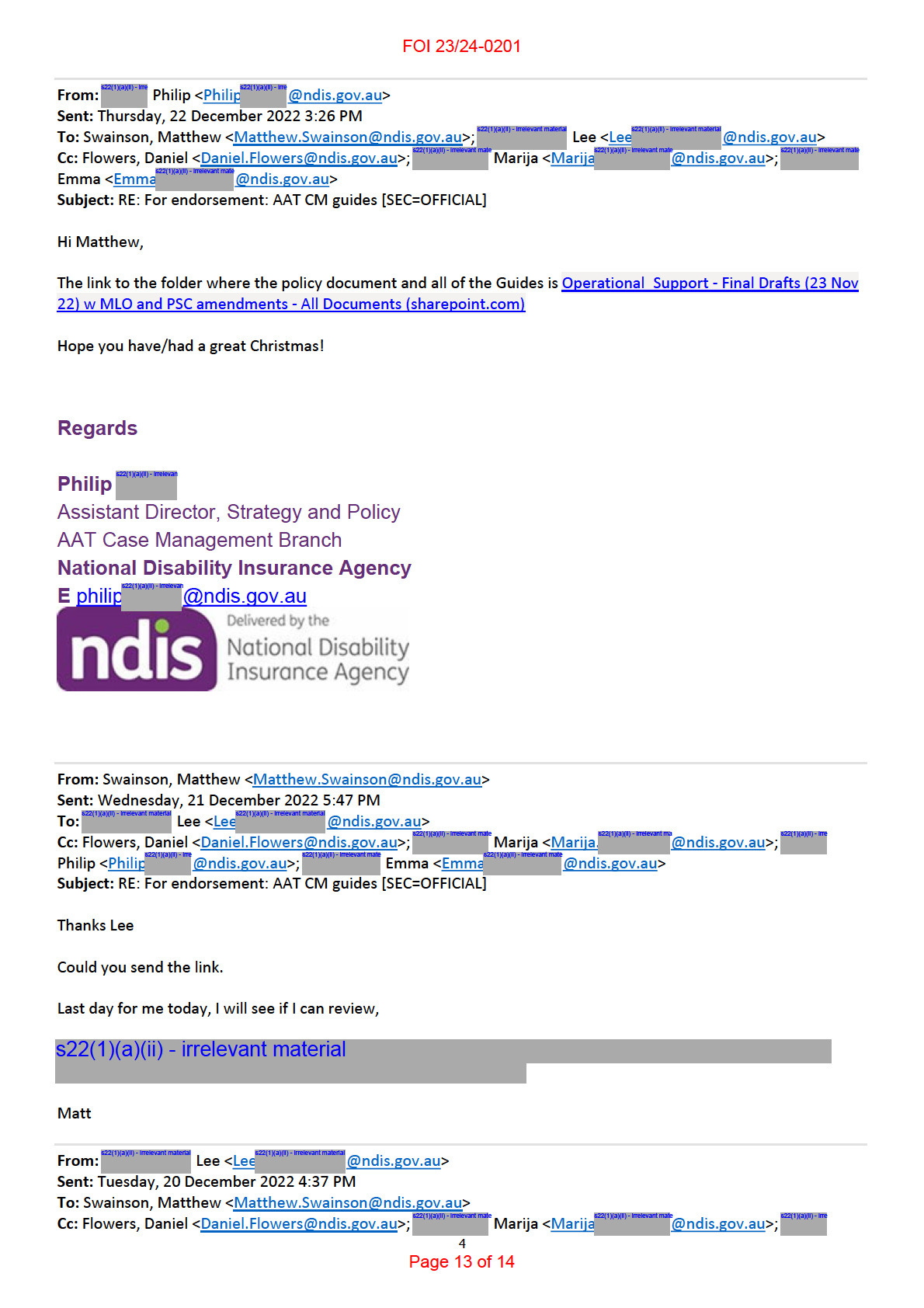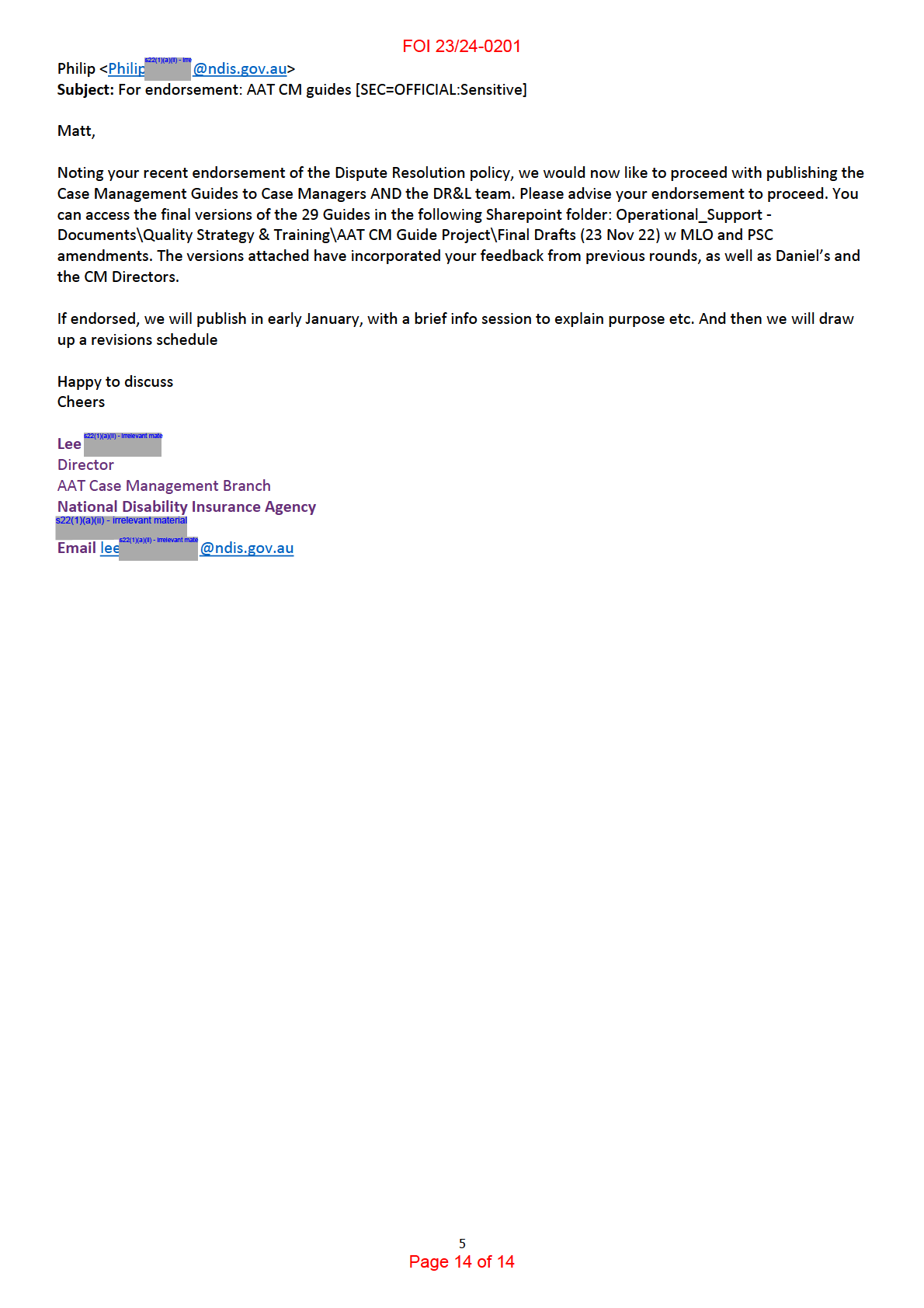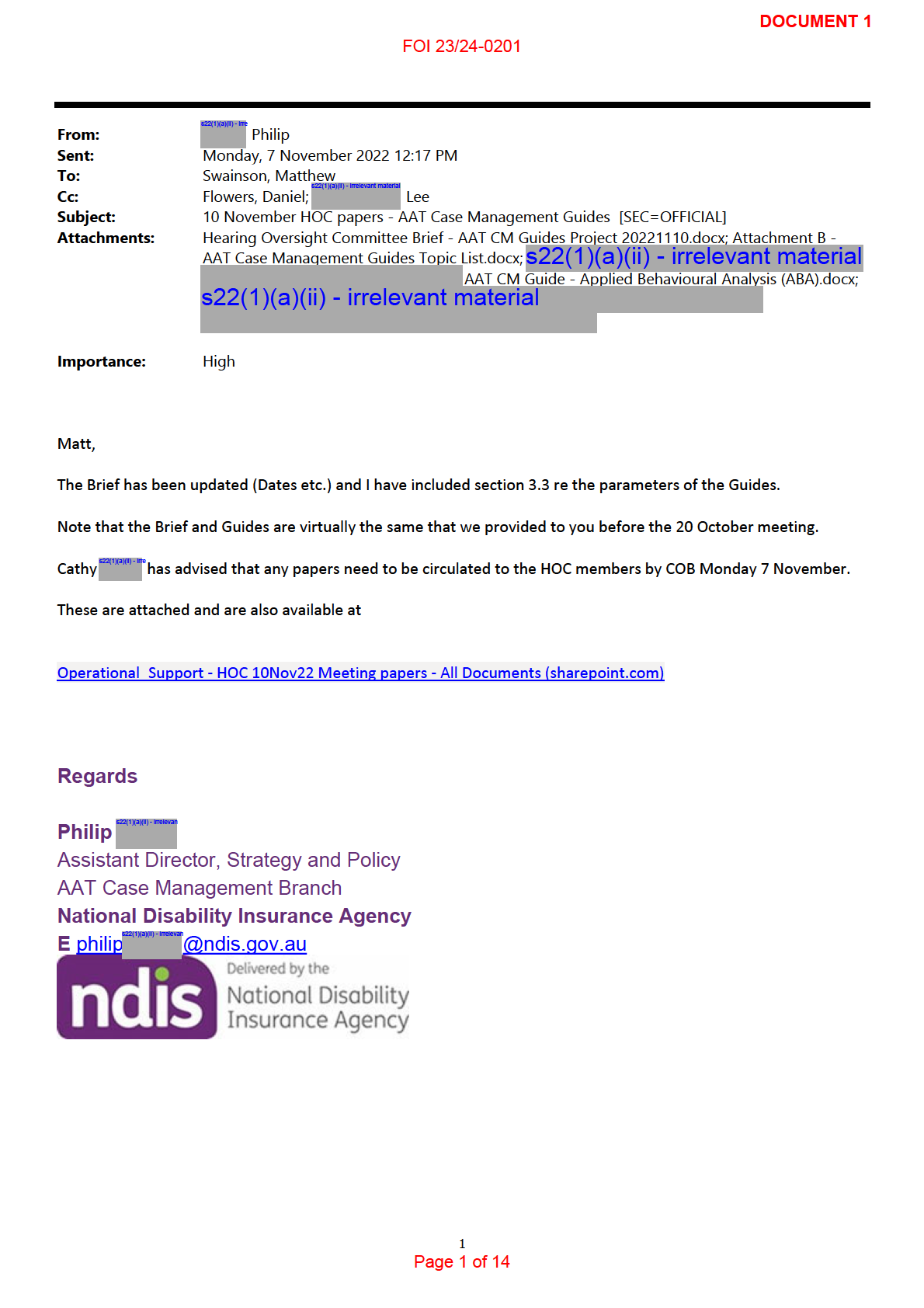
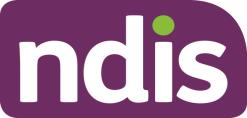 DOCUMENT 2
DOCUMENT 2
FOI 23/24-0201
Hearing Oversight Committee meeting
Meeting date:
10 November 2022
Agenda Item:
#
Agenda Item:
AAT Case Management Guides Project
Paper Type:
For Endorsement
ELT Sponsor:
Matthew Swainson, Chief Counsel
Draft resolution:
The Hearing Oversight Committee endorses the Six AAT CM Guides
presented to the meeting.
1.
Purpose
The purpose of this paper is to provide an overview of the current AAT Case Management
Guides Project and seek endorsement from the Hearing Oversight Committee of the Six
AAT Case Management Guides completed to date (See Attachments):
1. s22(1)(a)(ii) - irrelevant material
2. s22(1)(a)(ii) - irrelevant material
3. AAT CM Guide – Applied Behavioural Analysis,
4. s22(1)(a)(ii) - irrelevant material
5. s22(1)(a)(ii) - irrelevant material
6. s22(1)(a)(ii) - irrelevant material
1.1.
This endorsement is being sought for the Guides that provide Case Managers and other
stakeholders with guidance in formulating the position of the NDIA in managing matters
before the AAT, with respect to specific supports.
2.
Recommendation
2.1.
To endorse the use of the AAT Case Management Guides as being the position of the
NDIA regarding each of the nominated supports.
3.
Background
3.1.
A need was identified for a common plain English and succinct suite of guidance
documents identifying the various documents for consideration in formulating an
approach to managing the matter and outlining the NDIA’s likely position on the provision
of certain NDIS supports, based on legislation and experience.
3.2.
A Project was established in the Quality, Strategy and Training team within the AAT Case
Management Branch in August 2022. This Project was tasked with providing Case
Management Guides for 30 supports topics with extensive consultation within the
Branch’s Executive team, Subject Matter Experts both within the Branch and the wider
NDIA to ensure completeness and accuracy of the Guides.
3.3.
The Guides are to provide only a summary of the Supports and the NDIA’s likely
positions to act as a type of quick reference tool to assist both internal and external
stakeholders to develop a greater understanding of our case management approach.
4.
Budget
4.1.
The Project is utilising existing resources.
5.
Risks
5.1.
These Guides are designed to outline the NDIA position regarding the provision of NDIS
Supports to Case Managers and other interested parties. The Guides provide for each of
the covered supports sections covering description of the support, current NDIA Policy,
[Insert Title of Paper]
1
Page 2 of 14
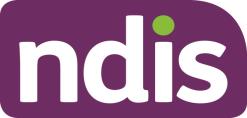
FOI 23/24-0201
Hearing Oversight Committee meeting
NDIA posture, supporting evidence requirements, other considerations and summary/ies
of previous AAT decisions that may be relevant. The Guides also include links to relevant
legislation, documents, papers and orders where required.
5.2.
The publishing of these Guides may increase the scrutiny that the Agency’s decision-
making processes are currently undergoing. This is considered of minor impact as the
Guides are distilling already published information from the NDIS Guidelines on the
internet, published decisions of the AAT and interpretations of the relevant legislation –
the Act and Rules.
6.
Impact
6.1.
The provision of the AAT Case Management Guides to Case Managers and the Agency
will assist with achieving the following outcomes and improvements.
6.1.1. Staff (especially New Starters) will have access to a ‘one stop shop’ re supports.
6.1.2. Business units throughout the Branch and the Agency will have access to the
latest NDIA policy and posture regarding the provision of supports that are covered.
6.1.3. The NDIA will have transparency regarding its decisions in internal and external
forums – i.e. the AAT will better understand our position when we are dealing with
the Members.
6.1.4. Participants and Providers will have a better understanding of how the NDIA has
formulated its approach to managing the matter.
6.1.5. These Guides will assist with satisfying the NDIA Participant Service Guarantee
and Model Litigant obligations.
7.
Responsibility and next steps
7.1.
The Branch Manager, AAT Case management has overall responsibility and oversight of
the Project. The Project team currently consists of the Director, Quality, Strategy and
Training, Assistant Director, Strategy and Three Paralegals and is responsible for the
initial drafting of the Guides, sourcing and collating feedback from users and Subject
Matter Experts and managing the publishing and general administration of the Guides
going forwards.
7.2.
The Project team will continue progressing the remaining 24 Guides which are currently
in various stages and the Project is expecting to have all the Guides competed by the
end of the year.
[Insert Title of Paper]
2
Page 3 of 14
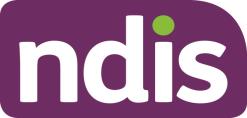
FOI 23/24-0201
Hearing Oversight Committee meeting
Attachments
Attachment A: s22(1)(a)(ii) - irrelevant material
AAT
CM Guide – Applied Behavioural Analysis, s22(1)(a)(ii) - irrelevant material
Attachment B: AAT Case Management Guides Topic List
Hearing Oversight Committee Endorsement: Yes/No/For Discussion at next meeting/For
discussion out of session.
Internal use only – removed for meeting
Prepared by:
Philip s22(1)(a)(ii) - ir/ Lee
Approved by:
Matthew Swainson
s22(1)(a)(ii)
- irrelevant m
Division:
AAT Case Management
Chief Counsel
Cleared by ELT
[ELT date]
[Insert Title of Paper]
3
Page 4 of 14
DOCUMENT 3
FOI 23/24-0201
Attachment B: AAT Case Management Guides Topic List.
s22(1)(a)(ii) - irrelevant material
4. Applied Behavioural Analysis (ABA)
s22(1)(a)(ii) - irrelevant material
Page 5 of 14
 DOCUMENT 4
DOCUMENT 4
FOI 23/24-0201
AAT Case Management Guide
Applied Behavioural Analysis (ABA)
OFFICIAL For Internal Use Only
Field
Content
Reference Documents
Title
Applied Behavioural Analysis (ABA)
This document is part of a suite of guidance
documents for case managers to use in formulating
Purpose
their approach to managing individual cases before
the Administrative Appeals Tribunal (
AAT).
ABA therapy refers to a non-pharmacological
behavioural intervention to help children diagnosed
Applied Behavioural
with Autism Spectrum Disorder (
ASD), intellectual
Analysis (ABA) Therapy
disability or developmental delay to develop skills in
| Disability Support
communication, self-care and social interaction, and
Guide
or reduce behaviours that are barriers to learning and
Scope
participation.
Behavioural
interventions | NDIS
ABA is one of a number of different evidence-based
approaches to support children with ASD. It is
Autism CRC early
characterised by intensive interventions, delivered by
intervention report |
trained personnel in a clinical or childcare
NDIS
environment.
Escalation to
If a matter is within the parameters of this document,
Hearing
the AAT CM Branch Manager may approve
Oversight
proceeding to hearing. Where there is substantial risk
Committee
or the matter is outside the parameters of this
(HOC)
document, the matter should be referred to HOC.
Section 34(1) of the
National Disability
The NDIA will fund ABA therapy if the NDIA is satisfied
Insurance Scheme Act
it is a reasonable and necessary support. Where ABA
2013
therapy is to be funded as an early intervention
Current
Rules 3.2 and 3.3 of the
support, the NDIA must also be satisfied that it is
National
National Disability
likely to reduce a participant’s need for future
Disability
Insurance Scheme
disability supports.
Insurance
(Supports for
Agency (
NDIA)
Supports for children with ASD should be evidence-
Participants) Rules
policy on the
based and delivered using a family-centred approach
2013
subject
that incorporates individual planning. ABA therapy is
Operational Guideline –
likely to NOT be delivered with a family centred
Applying to the NDIS
approach and more likely to be delivered in an allied
health clinic or childcare/school environment.
Operational Guideline –
Early childhood
approach
1
Page 6 of 14

FOI 23/24-0201
AAT Case Management Guide
Applied Behavioural Analysis (ABA)
OFFICIAL For Internal Use Only
ECIA National
Guidelines – Best
Practice in Early
Childhood Intervention
Council of Australian
Governments (
COAG) –
Principles to determine
responsibilities of the
NDIS and other service
systems
Operational Guideline –
Creating your plan
CXZS v National
Disability Insurance
Agency [2021] AATA
511
Intervention
The NDIA is likely to fund up to 20 hours per week of
Recommendations for
ABA therapy where it is considered likely to be
Children with Autism in
effective and beneficial.
Light of a Changing
Evidence from a meta-analysis of clinical studies
Evidence Base | Report,
indicates that it is unlikely that more than 15 hours
Dr M Sandbank et al
per week of ABA will be effective and beneficial.
(generalised findings,
specific to older
Where more than 20 hours of ABA is requested, the
children)
NDIA Posture
NDIA is most likely to run the matter to hearing. The
in relation to
matter will turn on the question of the participant’s
Autism CRC early
this subject
age, and their own capacity as well as their family’s
intervention report |
capacity to meet the time obligations of ABA therapy.
NDIS
Where a participant has commenced school and
The Department of
requests more than 10 hours of ABA per week, the
Defence (USA) |
NDIA must consider the capacity of the participant
Comprehensive Autism
and their family to sustain both full-time schooling
Care Demonstration
and intensive therapy.
Annual Report 2021
A Multisite Randomized
Controlled Trial
Comparing the Effects
of Intervention
Intensity and
Intervention Style on
Outcomes for Young
Children With Autism -
ScienceDirect
2
Page 7 of 14

FOI 23/24-0201
AAT Case Management Guide
Applied Behavioural Analysis (ABA)
OFFICIAL For Internal Use Only
Australia's First
National Guideline for
the Assessment and
To consider funding for ABA therapy, the NDIA
Diagnosis of Autism
requires evidence of a relevant diagnosis from a
Spectrum Disorders |
paediatrician, psychiatrist, psychologist or a specialist
Autism CRC
multi-disciplinary team. The Diagnostic and Statistical
List A: Conditions that
Manual of Mental Disorders, fifth edition (
DSM-5) is
are likely to meet the
the NDIA’s preferred diagnostic standard.
disability requirements
Evidence
| NDIS
recommended
Clinical evidence that ABA therapy satisfies the
to inform NDIA criteria in section 34(1) is also required to be provided Section 34(1) of the
position in a
by a psychologist, occupational therapist,
National Disability
specific matter paediatrician or, where a participant has received
Insurance Scheme Act
before the
ABA therapy previously - an ABA therapist.
2013
Administrative
Clinical evidence must address the link between ABA
Rules 3.2 and 3.3 of the
Appeals
therapy and a participant’s goals and specify how the
National Disability
Tribunal (
AAT)
requested number of hours of ABA therapy will be
Insurance Scheme
effective in assisting the participant to achieve those
(Supports for
goals.
Participants) Rules
Evidence from a behavioural paediatrician who has
2013
assessed the participant in person is recommended.
Persons Giving Expert
Professor Einfeld or Dr McDowell are recommended.
and Opinion Evidence
Guideline |
Administrative Appeals
Tribunal
The NDIA must also be satisfied that ABA therapy
Rule 5.1 of the
National
meets the National Disability Insurance Scheme
Disability Insurance
(
NDIS) funding criteria – in particular, that it:
Scheme (Supports for
•
Participants) Rules
is unlikely to cause harm to a participant or
2013
pose a risk to others; and
• is not duplicated by other funded supports.
How we work out if a
support meets the
Other
Consider the context and circumstances of the family
funding criteria | NDIS
considerations
and their capacity to support the delivery of 15 – 20
hours of intervention in the learning environment of
Autism CRC early
the child (usually the home or school).
intervention report |
NDIS
Also consider:
•
Section 3 of the
children with greater baseline cognitive skills
National Disability
and higher adaptive behaviour scores at
Insurance Scheme Act
baseline have better outcomes from early
2013
intensive ABA therapy; and
3
Page 8 of 14

FOI 23/24-0201
AAT Case Management Guide
Applied Behavioural Analysis (ABA)
OFFICIAL For Internal Use Only
• younger children have better outcomes from
ABA therapy.
The NDIA must also have regard to a participant’s
choice and control in the pursuit of their goals and
the planning and delivery of their supports.
The AAT will not consider whether ABA therapy is an
FRCT v National
effective early behavioural intervention strategy for
Disability Insurance
children diagnosed with ASD, but whether ABA
Agency [2019] AATA
therapy satisfies the criteria in section 34(1), which
1478
will be determined on the facts of each case.
Previous
WKZQ v National
When considering funding for ABA therapy, the NDIA
matters that
Disability Insurance
must also consider the promotion of an applicant’s
may advise the
Agency [2019] AATA
choice and control in the pursuit of their goals and
NDIA position
1480
the planning and delivery of their supports.
CXZS v National
It is the responsibility of the NDIA to show that ABA
Disability Insurance
therapy can be substituted with other mainstream
Agency [2021] AATA
therapies and achieve the same outcomes for the
511
applicant.
Document
DRAFT Version 0.6
2 November 2022
admin
Quality, Strategy and Training
Approved
Matthew Swainson, General Counsel
Endorsed
Hearing Oversight Committee
4
Page 9 of 14
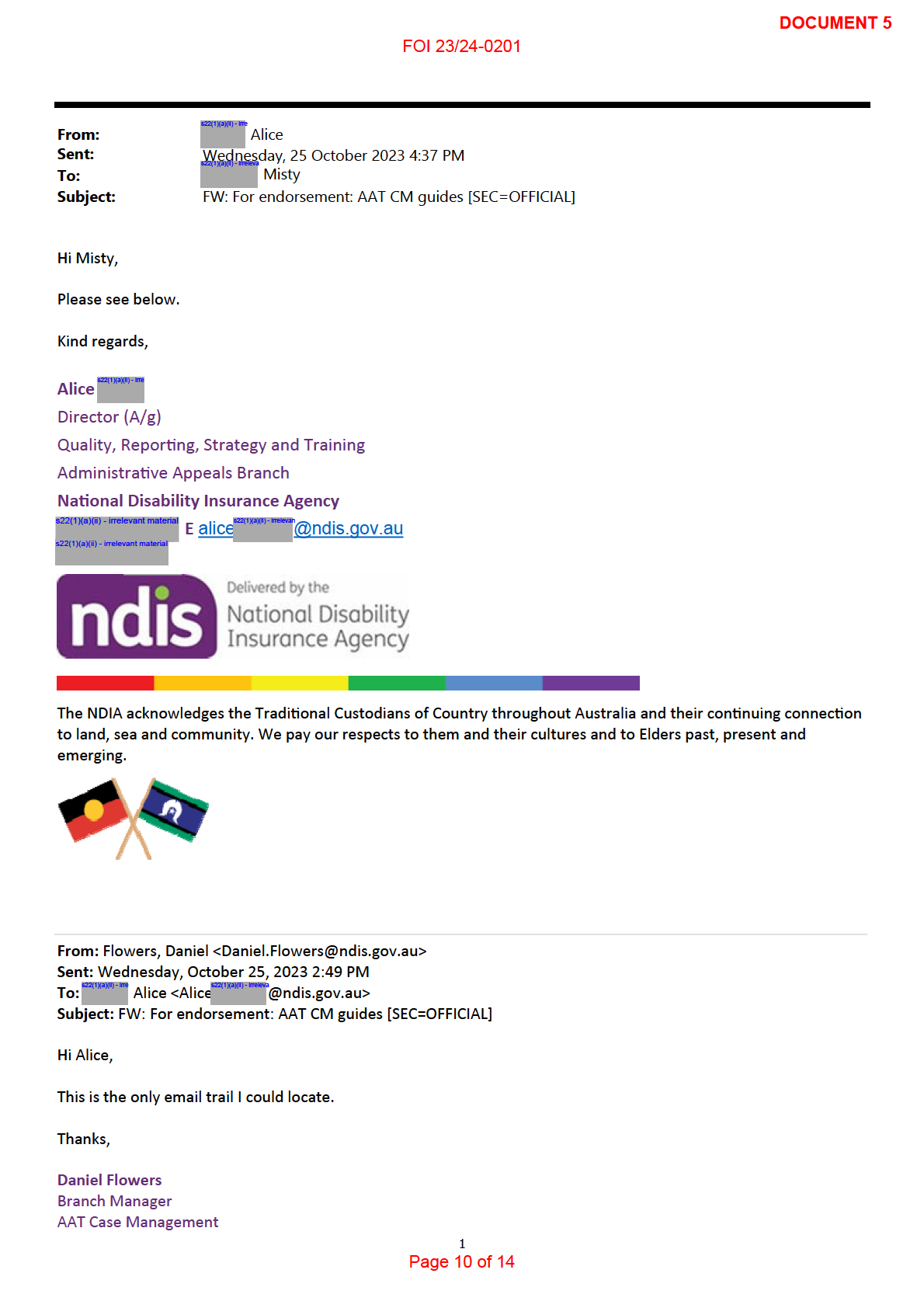


FOI 23/24-0201
s22(1)(a)(ii)
- irrelevant mate Jess <Jesss22(1)(a)(ii)
@ndis.g
- irrelevant mate
ov.au>; s22(1)(a)(ii)
- irrele Simon
<Simons22(1)(a)(ii) @
- irrele
ndis.gov.au
>
Subject: RE: For endorsement: AAT CM guides [SEC=OFFICIAL]
Hi Matt,
Re #1 below. Yes, there will need to be a scheduled review (initially 6 monthly, Lee, please confirm) in addition to
any considerations as part of the post decision SOP that is also being updated (DR&L are the lead on this).
s22(1)(a)(ii) - irrelevant material
Phil/Lee, feel free to add/correct anything above.
Thanks,
Daniel Flowers
Branch Manager
AAT Case Management
National Disability Insurance Agency
s22(1)(a)(ii) - irrelevant material
Email xxxxxx.xxxxxxx@xxxx.xxx.xx
The NDIA acknowledges the Traditional Custodians of Country throughout Australia and their continuing connection
to land, sea and community. We pay our respects to them and their cultures and to Elders past, present and
emerging.
From: Swainson, Matthew <xxxxxxx.xxxxxxxx@xxxx.xxx.xx>
Sent: Thursday, 5 January 2023 5:22 PM
To: s22(1)(a)(ii) - irre Philip
<Philips22(1)(a)(ii) - xxxx@xxxx.xx
v.au>; s22(1)(a)(ii) - irrelevant material Lee <Lee.s22(1)(a)(ii) - irrelevant xxxxxxx@xxxx.xxx.xx>
Cc: Flowers, Daniel <xxxxxx.xxxxxxx@xxxx.xxx.xx>; s22(1)(a)(ii)
- irrelevant mate Marija <Marijas22(1)(a)(ii)
@ndis.gov.au
- irrelevant mate
>; s22(1)(a)(ii) - irrelevant mate
Emma <Emmas22(1)(a)(ii) - irrelevant xxxx@xxxx.xxx.xx>; s22(1)(a)(ii)
- irrelevant mate Jess <Jesss22(1)(a)(ii)
@ndi
- irrelevant mate
s.gov.au>; s22(1)(a)(ii)
- irrele Simon
<Simons22(1)(a)(ii) @ndis.gov.a
- irrele
u>
Subject: RE: For endorsement: AAT CM guides [SEC=OFFICIAL]
Hi Philip and team
Great piece of work, much appreciated.
You’ll see I’ve been working through the documents and I can see Philip has been responding to comments – thanks.
I will keep working my way through, though possibly Monday now.
I have a two broader comments:
1. Confirmation about the process for keeping these updated. Do we review after an AAT decision or HOC
position that changes the posture. Also where we have identified model litigant issues with our approach.
s22(1)(a)(ii) - irrelevant material
Ideally I would like a continuous improvement loop that connects to model litigant/participant experience – is this
the vehicle?
Matt
3
Page 12 of 14
